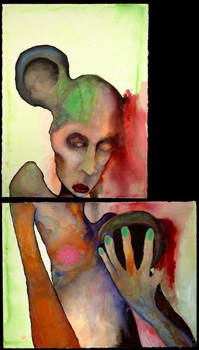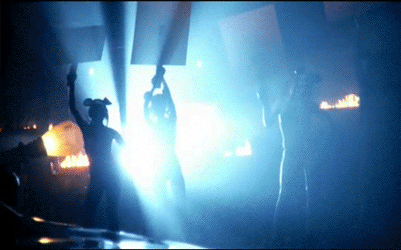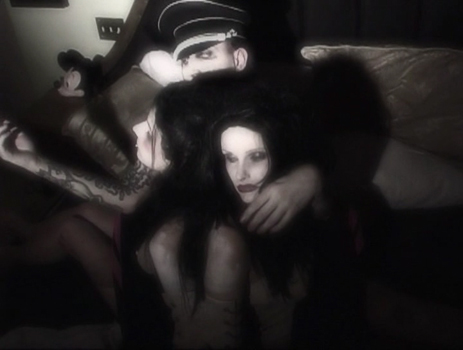the NachtKabarett
All Writing & Content © Nick Kushner Unless Noted Otherwise
In collaboration with Gilles R. Maurice
While I was previously seeking to express who I am with violence, [The Golden Age of Grotesque] marks a superior stage, the one that comes after the fight orchestrated on my preceding albums. My work is here to say : "Here's what I represent, here's my concept, here's my Disneyland."Marilyn Manson, D-Side, May 2003 (translated from French)
 |
 |
 |
| Left, right; Death's Head insignia worn by the elite Nazi Schutzstaffel (SS) & Disney's Mickey Mouse Club logo. Center; image from Manson's collaboration with Helnwein, who unveiled in a YouTube video clip he posted in 2009. Thanks to MaryWhore for making it re-surface on the Babalon message boards. | ||
"These days I'd much rather be the president ofMarilyn Manson, Q magazine, April 2004
the Mickey Mouse Club than get into politics."
Perfectly concluding Marilyn Manson's collaboration with Gottfried Helnwein on a series of portraits entitled The Golden Age, this remarkably satirical logo appeared in two versions, a black on white with red circle and a white on black one, respectively on Manson's podium during his Grotesk Burlesk tour and in the tour book illustrating this series of concerts. While the usually white Totenkopf (or Death's Head) has been switched to black, mimicking Manson's aesthetics of the era with black face makeup and white lips and eye sockets, the red circle borrowed to the Mickey Mouse Club's logo is in perfect continuation with Manson's own 1996 Shock logo. The result perfectly expresses the dichotomies employed by Manson during this period, between Nazi youth and Swing Kids, Mickey Mouse youth and Goth kids, expressionism and fascism like a modern day Dadaist would operate, eventually conveying a strong political statement about fascism in America and its entertainment industry (and also being in that sense a precursor for Manson's later Dollar-sign logo).
The strong analogy between our rock star's initials and those of the beloved celluloid Mouse is indubitably messing with the spectator's perceptions on a subconscious level...
"Inhale, exhale, let's all hail"Ka-boom Ka-boom
It's a depraved new world / After all
 |
 |
Left; "I'm not a slave"; performance of The Fight Song with Manson made up in black face wearing Manson Mouse ears above a rodent Death's Head emblem on the Grotesk Burlesk. Manson's own version of the Nuremberg rallies which brings together the dichotomy of the polar opposites of expressionism and fascism. Right; page from the Grotesk Burlesk Tour book, with a white version of the same logo, echoing Manson's whitened or blackfaced photographic shots of his collaboration with Helnwein. The logo can thus be seen as literally representing Manson's face, very much like his Omēga logo during Mechanical Animals. |
|
All the art we have done, has many levels, but in regards to Mickey...his image was also considered to be 'degenerate' by the fascist government in [1930's Germany]. In America he represented so much more. These are pieces of the imagination, no more, no less.Marilyn Manson
 |
 |
| Chaplin in The Great Dictator, with the double cross of Tomania replacing Hitler's Swastika. Among all of Manson's references to fascism, this parallel remains the most striking in the album's context, given the 'degenerate' dimensions of Mickey Mouse and Chaplin's characters, both expressing anti-fascism through parodies in cinematographic works, besides just coexisting in the same period or zeitgeist. Right; "It's a depraved new world, after all", line originally from'Ka-boom Ka-boom' introducing Manson's Chaplin-esque performance of 'The Fight Song' at Ozzfest 2003. Combining Aldous Huxley's "Brave New World", depravity of Weimar's atmosphere, and the horripilating song from Disneyland's attraction "It's a Small World" (after all), which is also quoted in the Journal. | |
These are the "traditional" values that have built "protective," moral walls around our children's world.Marilyn Manson, 'Putting Holes In Happiness'
And it is, indeed, a small world after all.
MarilynManson.com, 3/3/2003
Thematically, Manson's mock portrayal of fascism and Nazi imagery is reminiscent of Charlie Chaplin's highly controversial 1940 film, The Great Dictator, in which he ridicules Hitler & the Nazi party by satire, using comedy as a means to warn the world of the very real dangers of the impending fascism of the late 30's. And Manson has done so in a very similar sense in regard to the parallels of repression today, both by religion & government but also to decry the imposition of self-censorship which is forced and ingrained into society today. For more on Manson's references to Blackface, Chaplin, the Nuremberg rallies and the Death's head please visit our "Degenerate" Art & Fascism section.
 |
 |
 |
| Left; Adolf Eichmann head of the Gestapo department for Jewish affairs. Center; Photograph of Manson with mouse-eared cap and identifiable SS Death's Head badge, from his Golden Age of Grotesque collaboration with Helnwein though it only surfaced in 2006, in MarilynManson.com's Phantasmagoric introduction. The animal attributes and metal teeth are those of a Beast of Revelation. Right; Manson with SS visor cap, minus the Nazi adornments. | ||
"Well, there's a song called 'Doll-Dagga Buzz-Buzz Ziggety-Zag' and just about everybody in the band played drums on it at one time because it's very much a big-band beat. And I wanted to combine a little bit of a marching band feel - the Mickey Mouse Club mixed with Nuremberg rallies, the whole spirit of political upheaval..."Marilyn Manson, April 2003
 |
 |
| Left; Totenkopf/Death's Head badges usually attached on SS headgear (or embroided on insignias), adopted by the Nazis from their historical tradition to use it for their own purposes, leaving it marked with a stigma that has continued to the present day. Right; John 5's guitar pick during the Grotesk Burlesk tour. | |
I'm the leader of the club / And I've shrugged off my mouse earsKa-boom Ka-boom
 Collaboration between Helnwein and Manson for The Golden Age Of Grotesque, originally intended to be the front and back covers of the album itself, with cut ear to avoid copyright infringement. The dichotomy of Black and White, Marilyn and Manson, America and Europe, Blackface comedy and Pierrot from Commedia dell'Arte (note that Pierrot's girlfriend actually responds to the name Columbine...
Collaboration between Helnwein and Manson for The Golden Age Of Grotesque, originally intended to be the front and back covers of the album itself, with cut ear to avoid copyright infringement. The dichotomy of Black and White, Marilyn and Manson, America and Europe, Blackface comedy and Pierrot from Commedia dell'Arte (note that Pierrot's girlfriend actually responds to the name Columbine...I was not allowed to put the paintings on the cover of the record! Our anticipation was not to create album artwork. We wanted to create a collaboration, and from that came the idea to use it for the cover, because we did not consider the Golden Age of Grotesque to be limited to an album. An album is very limited with censorship, and with time constraints and space constraints. We did intend for the white and black images of me with the ears to be the front and back.Interview with Marilyn Manson for INROCK
I feel the black one is very American, and the white one is very European. The black one is somewhat more evil, and the white one is kind of innocent. I actually think that the white one, visually, strikes me as more evil. It's like a Pierrot. You know, American versus European. The entire time that I did it, I don't think anyone mentioned the blackface and the relevance of it. The relevance of it is the exploitation of a performer, or an artist. The Mickey Mouse was invocative because of the hat, and a lot of people feared that it would be a lawsuit from Disney, but it does not even, in it's fullest frame, show both ears. The hat that I ended up making is very similar, but it's asymmetrical, because I have a real problem with symmetry. I like things to be different on both sides, like my brain. The white one, on the other side, is like the child.
By Evie Sullivan, July 2004
 |
 |
 |
| Left and right; Two other examples of Helnwein's photographic works for The Golden Age series, all of which can still be seen on his website. Center; still frame from 'This Is The New *hit', showing the giant inflatable replica of Manson's mouse-eared and blackfaced head that was used during the Grotesk Burlesk tour. | ||
All I can say about it is I'm glad that it makes it into the collection of images that represent me as best as it could. I think that it just scratches the surface of what Gottfried and I could do together. Also I think it was most appreciated and understood for it's biggest quality and it's biggest political impact.Interview with Marilyn Manson for INROCK
Like I said, people can take it anyway they want. People took it as serious as it could be in Europe, particularly in France and Paris, and in Japan because they saw my commentary on America. They saw me as much as people see Mickey Mouse as an American symbol. You cover your mouth with blackface, which really represents a franchise, moneymaking, and slave creation of entertainment, that isn't even human. That's an animal, on top of a podium that is exaggerated - a comedy form of fascism. It sounds very American to me. It sounds like a Happy Meal. That's not to say that's the only way you need to look at it.
By Evie Sullivan, July 2004
 |
 |
| Pictures of Marilyn Manson during the Grotesk Burlesk world tour, wearing black face and
asymetric Mickey Mouse ears. Left; picture by Bob Mussel, MarilynManson.com. Right; from Marilyn Manson's 2010 Biography special on A&E. |
|
"It's where theater goes off of the stage and becomes a reality of its own. It's the Nuremberg rally meets Walt Disney on acid. And stripped of religious and political meaning, it becomes its own religion and politics."Marilyn Manson for Las Vegas Review Journal, July 2003
 |
 |
| Left; Manson in front of The Berliner Dome with "May Belfort/Violet Hilton" and "May Milton/Daisy Hilton" for the Grotesk Burlesk. Right; in Berlin with Gottfried Helnwein during another performance in Berlin, also borrowing a lot to the Austrian artist's universe with the bandaged heads. | |
"It was time for The Grotesk Burlesk and dozens of mice scurried from the Kinderfeld. Their political organs had to be removed and we set them in formation, creating a metaphorical 'question mark.' ."Marilyn Manson's Journal
MarilynManson.com, 4/21/2003
 |
 |
| Left; Manson, Helnwein and Dita in 2004, posing in front of Helnwein's 2001 painting 'Midnight Mickey'. Right; 'Faunadestia', watercolor by Marilyn Manson. | |
Every artist has to do Mickey [Mouse] as a rite of passage. This is my interpretation. The title refers to the phobia of animals scratching their genitals. I think Andy Warhol did say America suffers from a rodent fetish. I enjoyed that.Marilyn Manson, about his painting Faunadestia
MTV.com, September 2002.
 |
 |
 |
| Left; another shot from the collaboration. Center; 2003 self drawing of Manson. Right; 'Anaclitism', Pernod and watercolor by Marilyn Manson. A double reference to Van Gogh and Mickey, as well as a possible hint to the fact his mousear had to be partially cut off to respect copyright laws. | ||
The devils are girls with Van Gogh's missing earThe Golden Age Of Grotesque
 |
 |
Left; a continuation of the theme in the recent video for "Arma...Geddon", where a crowd of blackfaced girls in mouse ears and star-spangled bikinis assault Manson with blank and white picket signs. Besides preserving the asymetry, the cut ear directly relates Manson's own mouse ear on the Golden Age shots that had to be partially cut for copyright reasons, and thus perfectly implement the numerous references to the theme of censorship flourishing in the video. Left Manson posing in front of a 2005 untitled work by Helnwein immortalizing a scene of Richard Strauss's 'Der Rosenkavalier', the stage and costumes of which were designed by him the same year, with a litteral re-utilization of the logo's concept. |
|
Gottfried Helnwein interviewed for Hard N' Heavy, May 2003HnH: One of your most famous paintings is a rather scary portrait of Mickey Mouse. Why did you decide to reuse the idea by photographying Manson in a similar way for the album's cover (which has been censored since then)?
GOTTFRIED HELNWEIN: I have often manipulated the image of Mickey Mouse and Donald Duck because I have always appreciated this trivial culture. Comic books are part of my roots and I consider them as full works of art. As an icon, Mickey possesses different aspects. It's a wonderful creation that became something appalling. A big commercial thing, and a symbol of multinationals. And Mickey has a cute side, eventually very artificial when you see how it was used for Manson (laughs)! And then, as Mickey is also a character that's known in the whole world, it's tempting to play with it.
(Translated from French)
MarilynManson.com new entryHelnwein, Manson, & Mickey Mouse...
Helnwein: "He's an icon that everyone on the planet would know. He's become a corporate identity. You look at Manson as Mickey Mouse, and it's the American dream turned into a nightmare." The Mickey portraits are only a small part of a larger collection of unnerving images that Manson will incorporate into his worldwide "Grotesk Burlesk" stage show. "The corporations, the media, they tell us to be shocked by images like these," Helnwein says. "Well, it's the world that's shocking to people like myself and Manson. There's no freedom. There's censorship. You're constantly being told how you should behave. What Manson and I have in common is the fact that we don't accept this. These images represent us fighting back."
[posted 9/7/2003 U.S.A.]
 |
 |
| Left; still frame from the video DOPPELHERZ, which announced many the themes and aesthetics of The Golden Age Of Grotesque era. Right; "Ginger tunes iron currycomb", one of the photographs unveiled on Marilyn Manson's Online Journal in a 2004 last post announcing the upcoming 'Best Of' album. | |
Marilyn Manson for Floridian, August 2003I constructed something that I think represents a satire of totalitarianism and control and restriction of art and conformity, and that deteriorates into degenerate grotesque burlesque. And into finally the ultimate childish deterioration. And that's why I used symbolism like Disneyland. Starting off with something like Nuremberg and ending with something like Disneyland takes you on a journey that represents everything that I have to say on this record. And somehow those two can be as scary as one another if you flip it around. Because American culture can be controlled by its own sense of self-imposed fascism: desire to fit in. That's a form of slavery of itself.


